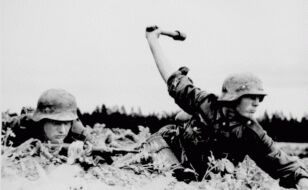
The Italian Campaign continued.

A German soldier throwing a stick grenade ( know as a 'potato masher' )
Eisenhower reasoned that the Volturno-Biferno line held by the allies, was too close to Naples and Foggia to give adequate security to those vital installations. He believed that the allies would have to force the Germans back to a line north of Rome to provide the secure areas around Naples that he wanted to establish. Also, if the allies occupied the Po valley, it would tie up the maximum number of German divisions possible as from there the allies could threaten Southern France, the Balkans and even Germany itself. Because of the troops and equipment being siphoned off to England for the forthcoming invasion of France, Eisenhower reported that "This shortage will force us into frontal attacks which will undoubtedly be strongly contested and prove costly", it was to prove an accurate prophesy.
Kesselring had established two main 'blocking' lines and was counting on the Italian winter as his ally. The German infantry also had high morale, they were glad to be ending the 2,000-mile retreat from El Alamein and they had ample time to construct strong defences all across Italy with plenty of mines, booby traps and other surprises to greet the advancing allies. Cloud cover often prevented close air support, the steep mountain slopes confined armor to the muddy valley roads where it was easy prey for German artillery and anti-tank gunners. Even allied artillery wasn't much use, the lack of roads, washed out bridges and mud, limited the amount of shells that could be brought forward and most German bunkers were proof against all but a direct hit. The allies had to devise new attacking methods involving infantry advancing behind artillery to within small arms range, then taking the German positions one at a time with grenades and small arms fire, a very slow way to advance indeed. One German soldier described these tactics in a local soldiers newspaper:
"The Americans used quasi Indian tactics. They search for the boundary between battalions or regiments, they look for gaps between our strongest points, they look for the steepest mountain passages (guided by treacherous civilians.) They infiltrate through these passages with a patrol, a platoon at first, mostly at dusk. At night they reinforce the infiltrated units, and in the morning they are often in the rear of a German unit, which is being attacked from behind, or also from the flanks simultaneously".
These tactics were costly and allied soldiers paid the price. After 10 days in combat, the 6th Armored Infantry Regiment had suffered 66 men killed, 379 wounded, 480 men missing in action and 516 evacuated for trench foot and exposure. The turnover rate for infantry lieutenants in VI Corps from October to January was 115 percent. By January 15, 1944, the allies were closing on the Rapido River, yet the Germans had won the battle even though they lost the ground. Not once had the allies forced them off a delay line before it was scheduled for abandonment. During their four month withdrawal Kesselring's troops had accomplished all the classic tasks of a delaying action. The allies arrived at the new German defensive line exhausted, punished, harassed and having wasted much time just to get into an unfavorable position. They now faced an enemy determined to withdraw no more and entrenched in a formidable defensive position.
The allies however had no intention of battering their way through the German defences in simple frontal assaults, they still had the advantage of the Navy and its amphibious capability. There were a few problems to mounting amphibious assaults however, the amount of available shipping and landing craft not being used to build up and supply the forces in southern Italy was only enough to lift a single brigade. Also, the only beaches suitable for invasion were too far north to allow a link up within 48 hours which is about how long a brigade could hold out. The allied commanders still squabbled about the priorities, Churchill wanted to seize Rhodes and Rome before going ahead with the invasion of France, the Americans weren't the least bit interested in Rhodes although they did want to take Rome. In the end the invasion of France was postponed for a month, Rhodes disappeared from the picture and General Alexander had the landing craft and ships he needed for an extra month. Thus the battle for Italy moved to it's next phase, Anzio and Cassino.
The Anzio plan involved VI Corps landing at Anzio and driving inland to seize the Alban hills, thus cutting of the Germans on the western end of the Gustav line. Five days before the landing, Fifth army would cross the Garigliano and Rapido rivers and assault the Gustav line thereby holding enemy forces way from Anzio, drawing reserves from Rome to the Gustav line and penetrating the Gustav line to link up with the Anzio assault force. Kesselring awaited the allied attack with confidence, the Gustav line was a natural defensive position overlooking the Garigliano and Rapido rivers, the German engineers had plenty of time to build formidable bunkers and more mines, wire, etc, were used than before (the mines were wooden cased and very hard to detect). On January 17, the British X Corps attacked across the Garigliano and after hard fighting, had by the 19th established a two mile bridgehead. The American II Corps 36th Division, attacked across the Rapido, their assault was poorly planned, the troops unwilling and the leadership uninspired, and, after 48 hours of battering by the Germans Major General Keyes called off the attack. After some disastrous rehearsals the Anzio operation went ahead, although the allied commanders had different understandings of what the VI Corps mission was. after achieving tactical success the invasion bogged down and the Anzio beachhead became an island surrounded by the German 14th Army.
